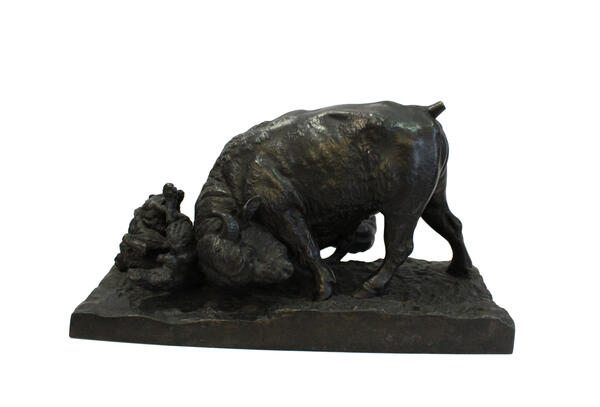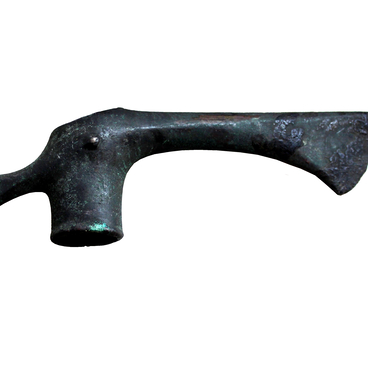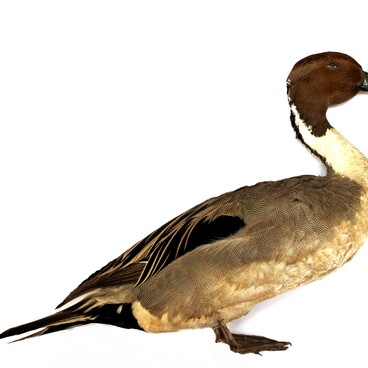The sculpture ‘The Bison Fighting the Wolves’ was brought to the Syzran Museum of Local History and Lore from the Usolye estate of the Orlov-Davydovs in 1925. The sculpture depicts a fight between a bison and a pack of wolves. The bison is trying to use its horns to toss away a wolf that is lying on its back with its teeth bared. Another wolf has bitten down on the right front leg of the bison. In their natural habitat, wolves are the bison’s worst enemy. When a pack of wolves attacks, bisons form a circle to fight back. Young animals and weak females hide in its middle. Big males fend off the attacking wolves with their horns.
On the left side of the base of the sculpture, one can see the inscription W. WOLFER, the label of the author, the German sculptor Albert Moritz Wolff. Born in 1854, he graduated from the Berlin Academy of Arts. He made monumental sculptures, medals, and plaques as well as bronze office sculptures. From 1881 onwards, Wolff’s works were garnering positive reviews at art exhibitions. He became famous after his sculpture Judith was included in an exhibition in 1893 and was featured in the catalogue. He also minted medals. Between 1904 and 1913, he created a series of commemorative medals.
Wolf had intimate knowledge of the works of Russian sculptors from the late 19th century, which were regularly displayed at various exhibitions. A common opinion is that the German master joined in with the youngest generation of Russian pre-revolutionary miniature sculptors and created a series of memorable images depicting life in Russia in the late 19th and early 20th centuries.
His Russian-themed works feature scenes of people riding in troika-drawn sleds and carts, wolf attacks, horse-mounted cossacks, young cossack women, and Circassians. One thing that spurred all this imagery was a profound interest in Russian desk sculptures that depicted ethnic-themed scenes among Europeans. Attributing works to Albert Moritz Wolff is made harder by the lack of labels on bronze pieces as well as frequent mistakes in the name of the author on specific cast pieces.
On the left side of the base of the sculpture, one can see the inscription W. WOLFER, the label of the author, the German sculptor Albert Moritz Wolff. Born in 1854, he graduated from the Berlin Academy of Arts. He made monumental sculptures, medals, and plaques as well as bronze office sculptures. From 1881 onwards, Wolff’s works were garnering positive reviews at art exhibitions. He became famous after his sculpture Judith was included in an exhibition in 1893 and was featured in the catalogue. He also minted medals. Between 1904 and 1913, he created a series of commemorative medals.
Wolf had intimate knowledge of the works of Russian sculptors from the late 19th century, which were regularly displayed at various exhibitions. A common opinion is that the German master joined in with the youngest generation of Russian pre-revolutionary miniature sculptors and created a series of memorable images depicting life in Russia in the late 19th and early 20th centuries.
His Russian-themed works feature scenes of people riding in troika-drawn sleds and carts, wolf attacks, horse-mounted cossacks, young cossack women, and Circassians. One thing that spurred all this imagery was a profound interest in Russian desk sculptures that depicted ethnic-themed scenes among Europeans. Attributing works to Albert Moritz Wolff is made harder by the lack of labels on bronze pieces as well as frequent mistakes in the name of the author on specific cast pieces.



